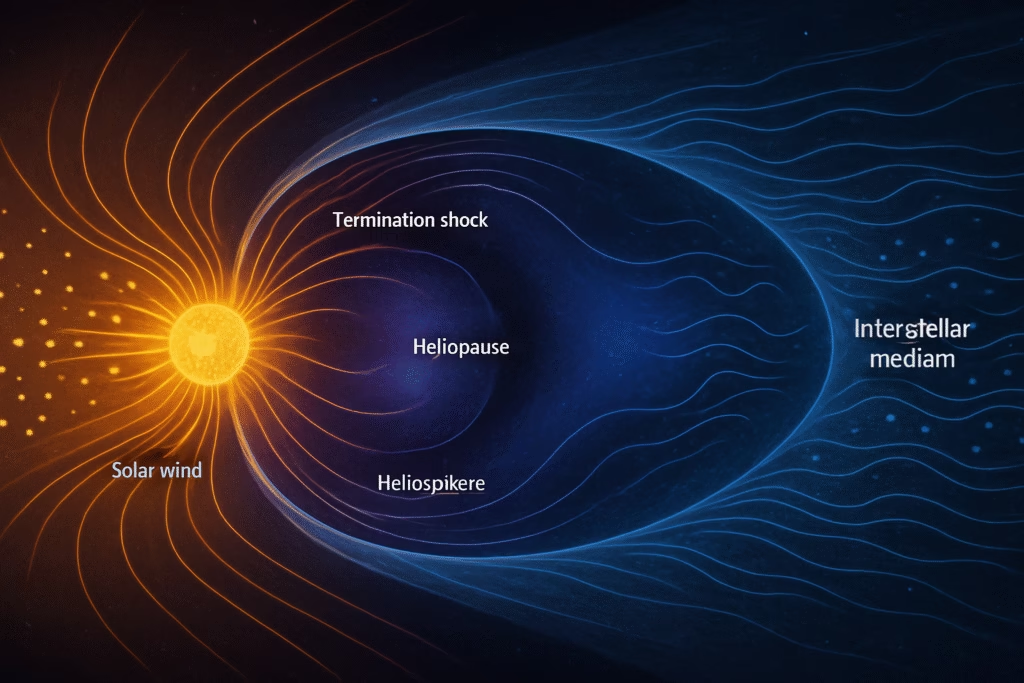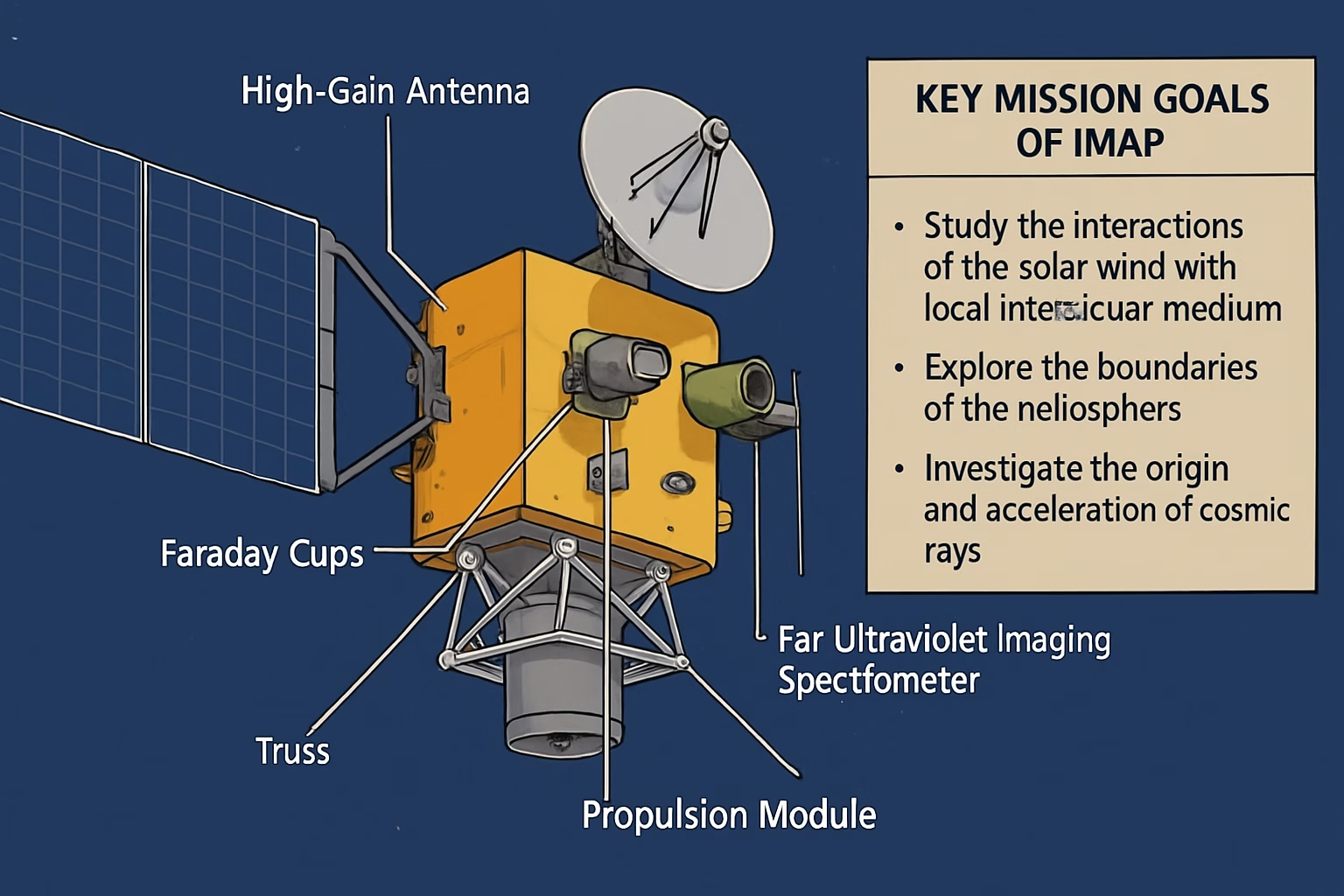A New Era in Space Travel
A momentous NASA mission is going to make history in space research in 2025. The Interstellar Mapping and Acceleration Probe, or IMAP, is what it’s called.
It will go to the end of the solar system, which is farther than any spacecraft has ever been. Have you ever wondered how solar winds affect the universe? Or how the edges of our solar system shape our world?
IMAP is about to give you answers. This mission promises to reveal mysteries about the solar wind. It will also clarify mysteries about cosmic rays. Additionally, it will explore the line that separates our solar system from interstellar space. It will open up a new chapter in the study of the universe.
Table of Contents
What is IMAP?
At the border of our solar system, the solar wind encounters interstellar space. NASA’s Interstellar Mapping and Acceleration Probe (IMAP) is conducting research there.
Unfortunately, the Voyager spacecraft lack the technology to conduct in-depth investigations after having beyond the solar system’s boundary. In contrast, IMAP will primarily investigate the heliopause. This boundary is between the solar wind and the interstellar medium.
IMAP is about to offer us never-before-seen information about the heliosphere. Heliosphere is the bubble of charged particles and magnetic fields that come from the Sun. It will show how they interact with the fabric of interstellar space.
Scientists want to learn more about the galactic environment. They also aim to understand the mechanisms that control our space weather by studying this interaction. This has real-world effects on Earth.
Important Information on What is IMAP?
- Launch Year: 2025
- Mission Duration: Expected to last at least 6 years
- Goal: To learn more about space weather and how the solar wind affects matter in space.
- IMAP will work from the L1 Lagrange point. This is a stable position between the Earth and the Sun. It is perfect for doing observations all the time.
The Science Behind IMAP’s Mission– Getting More Closer to What is IMAP?
IMAP will look at the area where the solar wind meets the interstellar medium. This interstellar medium is a huge collection of particles, gasses, and magnetic fields that fill space.
The solar wind is a stream of charged particles that the Sun sends out. It makes the heliosphere. This protective bubble keeps a lot of galactic radiation from reaching the planets in our solar system.
Unfortunately, studying the solar wind isn’t IMAP’s only responsibility. Important for predicting “space weather,” it concerns understanding the solar wind’s slowing down and its interactions with the “interstellar medium.”
Satellite communication systems will be directly affected by this data. Global positioning systems (GPS) and other Earth-based technology reliant on space weather will also feel its impact.

Illustration of solar wind interacting with the interstellar medium at the heliopause boundary.
Main Goals of IMAP
IMAP’s main scientific goals are to:
- Mapping the Edge of the Heliosphere
IMAP will create comprehensive maps of the heliopause. This is the line that separates the solar wind from interstellar space. IMAP will achieve this by observing how the solar wind interacts with the interstellar medium. This will help scientists learn more about how solar winds work and how cosmic factors affect them. - Researching the Acceleration of Cosmic Rays
IMAP will look into how cosmic rays speed up in the heliosphere. These high-energy particles can change the weather in space. Their high speed makes it harder for people to explore space. IMAP wants to learn how these particles move through space by looking at how they act. - Making Space Weather Predictions Better
The mission aims to enhance our understanding of space weather. This includes phenomena like solar flares and geomagnetic storms. This is crucial for satellite communication. It is also vital for navigation systems and even power grids. All of these can be affected by space weather occurrences.
A close look at IMAP’s tools- That Even More closer to question What is IMAP?
IMAP has the latest scientific tools. These tools allow it to research the interstellar medium, solar wind, and space weather. These capabilities help IMAP reach its big aims.
Some of the most important tools are:
- Faraday Cup Detectors: These will check the charged particles in the solar wind, like electrons and ions. This will help scientists figure out where they came from and how much energy they have.
- Far Ultraviolet Imaging Spectrometer: This tool will examine interstellar hydrogen and study the characteristics of the heliosphere. This examination will help us better understand how particles and solar wind interact.
- Electrostatic Analyzer: The electrostatic analyzer analyzes the energy of particles. This helps scientists figure out how cosmic rays and solar wind speed up in space.
When used together, these tools give us a full understanding. They show how our solar system interacts with the universe around it.

Framework 1: The Matrix of Solar Wind and Interstellar Interaction
This matrix shows how distinct solar wind events affect stuff in space. Scientists can better understand the space environment when they know how these things work together.
| Interaction | Solar Weather | Space Weather |
|---|---|---|
| Solar Wind Expansion | Solar wind’s outside movement | Defines the external boundary of the solar system’s defensive field. |
| Cosmic Ray Acceleration | Boosting the velocity of charged particles | Has an effect on space weather, which is essential for space missions. |
| Heliosphere Interaction | Interactions between solar wind and gas between stars | Affects solar activity by modifying the strength and velocity of the solar wind. |
How IMAP Will Make Space Weather Forecasts Better
Space weather is typically thought of as a mysterious force. It can mess up anything from satellite communication to power grids. The data from IMAP will be very important for making these events’ forecasts more precise.
Solar flares, for instance, are abrupt blasts of energy from the Sun. They can create communication disruptions or even harm electrical infrastructure on Earth. Scientists will be capable of forecasting these events before they happen. IMAP shall always be watching the solar wind and the interstellar medium.
The instruments on IMAP will help predict geomagnetic storms. These storms occur when particles from the solar wind hit the Earth’s magnetic field. These storms can mess with GPS signals and cause problems for planes. Better forecasting will help lessen these effects by giving authorities more information to work with.
Case Study: What is IMAP and How It Will Make Predictions About Space Weather on Earth Better
Let’s say this is a hypothetical situation: In 2026, IMAP detects high-energy particles. These particles are unusually abundant at the edge of the heliosphere. This surge is caused by a solar flare that is expected to impact Earth in three days.
Space authorities send out early warnings to telecom and satellite service providers because of the data from IMAP. Airlines are told when GPS systems will not work.
The early warning system prevents these systems from going down for long periods. It also stops them from getting damaged. Failing to do so would cause a 10–20% reduction in communication bandwidth. It ensures that flight paths are changed on time.
Framework 2: The 5-Step Space Exploration Process
Exploring space is a complicated activity that involves theory, technology, and the skills of people. This is all part of a bigger plan, and IMAP is a part of it. Here are the five steps that show how space missions like IMAP work:
- Discovery and Hypothesis: Scientists make guesses about things like cosmic radiation and space weather.
- Mission Design: Space agencies come up with tools and plans for investigating these things.
- Launch and Observation: The mission starts, and data is gathered.
- Analysis and Testing: Scientists look at the data and have a better idea of how space weather works.
- Use and Effect: Data from IMAP will help make predictions about space weather and manage technologies on Earth.
The IMAP Mission: The Good and the Bad
Benefits
- Unprecedented Data: IMAP will give us important information about solar wind and space between stars.
- Better Predictions of Space Weather: It will help predict space weather events, which will make satellites safer.
- Technological Innovation: The mission sends new tools into orbit to help with future missions.
Disadvantages
- Costly: Space missions cost a lot of money, and delays can make them much more expensive.
- High Complexity: Understanding data from outside the solar system can be difficult. The analysis take years.
- Uncertain Timelines: Space exploration is always unexpected, and things can go wrong.
Common Questions What is IMAP?
- What is the goal of IMAP or What is IMAP? NASA’s IMAP mission aims to look at the edge of the solar system and the weather in space.
- When will IMAP go live? IMAP is set to start in 2025.
- How far will IMAP go? IMAP will work close to the heliopause, which is more than 15 billion miles from Earth.
- Why is IMAP important? It will help us learn more about space weather and make our technology safer on Earth.
- What tools does IMAP use? IMAP has a Faraday Cup detector, a Far Ultraviolet Imaging Spectrometer, and an Electrostatic Analyzer.
What to Do Next
- Follow IMAP’s Launch: To stay up to date on IMAP’s launch in 2025, go to NASA’s IMAP mission page.
- Find Out About Space Weather: Look at how space weather affects Earth. Learn about how IMAP’s data revolutionize how we keep an eye on it.
- Get Involved: Stay updated on new developments. Join space weather prediction groups. Follow IMAP on social media.
Discover more from NewsBusters
Subscribe to get the latest posts sent to your email.
